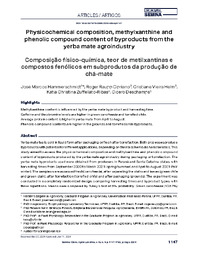Embrapa Florestas
 Busca de publicações
Busca de publicações
Physicochemical composition, methylxanthine and phenolic compound content of byproducts from the yerba mate agroindustry.
Autoria: HAMMERSCHMIDT, J. M.; CIPRIANO, R. R.; HELM, C. V.; ZUFFELLATO-RIBAS, K. C.; DESCHAMPS, C.
Resumo: Yerba mate tea is sold in liquid form after packaging or fresh after torrefaction. Both processes produce byproducts with potential for different applications, depending on their biochemical characteristics. This study aimed to assess the physicochemical composition and methylxanthine and phenolic compound content of byproducts produced by the yerba mate agroindustry during packaging or torrefaction. The yerba mate byproducts used were obtained from producers in Paraná and Santa Catarina states, with harvesting times from September 2020 to March 2021 (spring/summer) and April to August 2021 (fall/ winter). The samples were assessed fresh (cancheada), after separating the stalks and leaves (green chile and green stalk), after torrefaction (torrefied chile) and after packaging (grounds). The experiment was conducted in a completely randomized design, comparing harvesting times and byproduct types, with three repetitions. Means were compared by Tukey’s test at 5% probability. Green cancheada (10.57%) and torrefied chile (11.9%) exhibited higher caffeine and theobromine contents when harvested from April to August. The highest protein content was recorded in toasted chile grounds (16.10% in fall/ winter and 13.20% in spring/summer) and ashes (6.57% fall/winter and 6.29% summer/winter), and green powder (6.65% fall/winter and 6.62% spring/summer), for both harvesting times. Average protein content was higher in yerba mate grounds harvested from April to August (16.10%). In regard to phenolic compounds, grounds exhibited the highest 3-caffeoylquinic (33.62%), 4-caffeoylquinic (32.09%) and 3,4-dicaffeoylquinic acid contents (20.57%), and the torrefied chile samples the highest levels of 5-caffeoylquinic (46.09%) and 3,5-dicaffeoylquinic acid (31.64%), and grounds and torrefied chile the highest 4,5-dicaffeoylquinic acid concentrations, at 30.40 and 26.28%, respectively. Methylxanthine content was influenced by the type of sample and harvesting time, while phenolic compound content varied primarily as a function of type of byproduct and was higher in the grounds and torrefied chile samples.
Ano de publicação: 2024
Tipo de publicação: Artigo de periódico
Unidade: Embrapa Florestas
Palavras-chave: Cafeína, Caffeoylquinic acid, Chá, Compostos bioativos, Ilex Paraguariensis, Mate, Ácido cafeoilquínico

